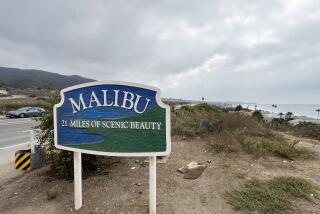Seismologists Sift Through Data for Clues to Quake’s Origins, Effect
Seismologists have been slow to shed much light on the abnormally low incidence of foreshocks and aftershocks surrounding Thursday’s earthquake because they have been overwhelmed by the task of collecting and processing data from the world’s most heavily monitored earthquake area.
Caltech and the U.S. Geological Survey operate nearly 600 earthquake monitors scattered throughout Southern California. Most are bolted to the floors of schools, firehouses and public buildings, but some are bolted to rock formations or buried in pits in parks and wilderness areas.
When a major earthquake strikes, the researchers’ first priorities are to notify state and local authorities about the disaster and then to pinpoint the epicenter of the quake as a guide to where emergency services will be required, said Don Anderson, director of the Caltech Seismological Laboratory. Then they try to determine how the quake occurred.
Collected by Technicians
Data from about half the stations are transmitted to Caltech electronically, but the rest must be collected by technicians who visit the sites after an earthquake to retrieve photographic film and magnetic tape and reset instruments.
Processing all the data collected during an earthquake and its aftershocks and putting them into a format useful to researchers can take weeks or months, Anderson said.
Meanwhile, teams of scientists and technicians from Menlo Park and Golden, Colo., fly in to assist. About 12 of them were in the quake area Monday collecting seismic data with additional sensors and assessing damage to buildings. Six others were using surveyors’ tools to determine if the elevation of the Whittier and Puente Hills was increased by the quake and if the Rosemead area had sunk two or three feet, as scientists believe.
That data will take months to calculate, said seismologist Thomas H. Heaton, head of the Pasadena geological survey office.
Processing the data is tedious and time-consuming, and the halls of the Caltech Seismological Laboratory were eerily quiet Monday as technicians bent to the task.
Around noon, for example, analysts Riley Geary and Dean Dougherty were huddled over computer terminals in a darkened room on the second floor, locating the epicenters of Thursday morning’s small aftershocks.
The computer displayed a data reading from each sensor--basically a straight line interrupted by a jagged tracing--for each shock. Geary and Dougherty, munching on taco salads as they worked, recorded the times when each shock began. “This kind of pattern recognition is very difficult for computers” so it must be done manually, Geary said. The process takes several minutes for a small quake, 15 to 20 for a large one, say magnitude 3 or larger.
By comparing the times at which seismic vibrations reached each sensor, the computer could then calculate the epicenter of the shock. So far, the instruments have recorded “a couple of hundred” aftershocks, Geary said, all but 25 of them below magnitude 3 on the Richter scale.
1,000 Aftershocks
By comparison, more than 1,000 aftershocks were observed during the same period of time after the July, 1986, Palm Springs temblor. Geary said it will take a couple of weeks to locate all the epicenters.
Other technicians were plotting the epicenters as soon as they were discovered, looking for telltale patterns that would suggest how the quake occurred.
Also on Monday, Caltech seismologist Kate Hutton and U.S. Geological Survey seismologist Lucille Jones--who have been the laboratory’s principal links to the news media and the public--departed for a firsthand inspection of the quake area.
“I’ve been studying earthquakes all my life, and I’ve never been to the epicenter of one,” Jones said.
More to Read
Sign up for Essential California
The most important California stories and recommendations in your inbox every morning.
You may occasionally receive promotional content from the Los Angeles Times.










